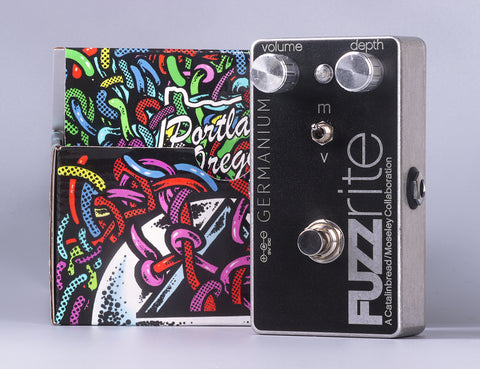Mosrite Fuzzrite Germanium

If you’re anything like me (and let’s face it, if you’re reading this, you are), you love a good fuzz pedal. And lord knows I’ve written about some fine ones, from the strange (Zoom Ultra Fuzz, Uni-Fuzz) and the traditional (Fuzz Face, Tone Bender). There are some very distinct flavors that I have yet to cover, and one of those is the almighty Mosrite Fuzzrite. But this isn’t just any Fuzzrite, this is the one with germanium transistors inside.
You are forgiven if you had no idea that there were two versions. For a while, I didn’t either. I had lived a good double-digit amount of years having thought only silicon versions existed. In fact, more than a few iterations exist, most of them purely cosmetic, with only three major topological varietals. The rarest by far is the germanium version, with original designer Ed Sanner recalling that only 250 or so made it out the door.
The story of the Fuzzrite itself is an often-told one, sharing some parallels with the original fuzz unit. No, not the Maestro FZ-1, but the broken tube inside Glenn Snoddy’s console that inspired it. Like the infamous faulty equipment, the birth of the Fuzzrite was inspired by another one-of-a-kind piece of gear, a fuzz box built by a man named Red Rhodes and used by the Ventures.
While it’s unclear if the Ventures ever used an actual Fuzzrite, the fuzz tones pressed into the albums sounded reasonably similar. And in the movie about the Ventures, Walk, Don’t Run, Nokie Edwards said he “believed” that Mosrite borrowed the design from the Rhodes unit.
Until somewhat recently, guitarists weren’t aware of the pitfalls of certain transistor elemental structures. But even back in the ‘60s, Mosrite knew the score. Like Hendrix and Roger Mayer discovered years later, Sanner and company found that germanium transistors in the original Fuzzrite changed the guitar tone depending on the ambient room temperature, and the idea was quickly abandoned. Fortunately for us fuzz lovers, either the other pedal manufactures didn’t know or didn’t care, going on to release hundreds of germanium-equipped fuzz pedals.
Even though a small amount of germanium Fuzzrites left headquarters, they found themselves in some very capable hands. Among the many other songs recorded with this box was Iron Butterfly’s “In-a-Gadda-Da-Vida,” quite possibly one of the greatest riffs ever recorded. In 1966, only two other fuzz pedals existed—the FZ-1 and the Tone Bender MKI—and importing exotic fuzz from England wasn’t really a thing (yet). To that end, it’s not like you could pop into just any store and buy an FZ-1; having only been hot for less than a year following the release of “Satisfaction (I Can’t Get No)”.
The three most well-known riffs that utilize “the Fuzzrite sound” were all recorded either in California or by Californians: the aforementioned Iron Butterfly track, “Incense and Peppermints” by Strawberry Alarm Clock and “Spirit in the Sky” by Norman Greenbaum. While the latter two have yet to be confirmed, the general consensus is that a Fuzzrite does the trick.
If you’re keen to play any of those riffs or riffs that sound like they could have been written in that time period, the silicon Fuzzrite will get the job done. However, there are some rather marked differences between the germanium and silicon versions. While the stock silicon Fuzzrite sounds excellent, deriving the germanium version isn’t a simple matter of swapping transistors. For example, the germanium version sounds far less gated then the original due to completely different biasing resistors. One such part is a carbon composition 10M resistor, an insanely high value for that type of material. Carbon comp resistors often have a tolerance of 10%, meaning they’re allowed to measure at 10% higher or lower the stated value while still being in spec. For a 10M resistor, otherwise known as 10 million ohms, 10% is a million ohms. One resistor might measure 2M ohms apart from another in the same bag. Isn’t vintage fuzz fun?
Thankfully, we’ve used this artifact to design a perfect replica of this original of ours. We hand-test both NOS transistors and the 10M resistor to ensure that each unit sounds like the one Iron Butterfly plugged into. If you’ve ever played an original Fuzzrite, germanium or otherwise, you’d be quick to notice a distinct lack of low end. We’ve included a Vintage/Modern switch that injects some much needed bass back into the fuzz tone, for a full-bodied fuzz with all the rip and zip of the original; a flavor previously only available to 200 or so people.
|

